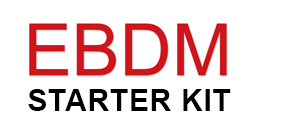EBDM Starter Kit
1j: Creating a Charter for Your Policy Team
Navigating the Roadmap

Activity 1: Build a genuine, collaborative policy team.
Introduction
Developing a written charter is a critical step towards achieving an effective team. It facilitates dialogue among team members about the ways that a group of individuals can and should operate, and it documents these agreements. Doing so ensures that these agreements are understood by all, facilitates the orientation of new team members, and supports the accountability of individual team members, as well as the team as a whole.
The policy team charter should define the purpose of the team, outline its vision and mission, and explain how it will work together. The charter is important as it
- defines common objectives and the shared intent of the team;
- keeps the team focused and helps the team determine when it goes off track (i.e., when activities go beyond the scope of the team);
- defines team boundaries and agreements; and
- helps team members determine when to raise an issue.1
The charter serves as a roadmap for the team’s work together and should be referred to when “times get tough.” It should be developed jointly, in principle if not in practice, and be agreed upon by all team members. Signatures on the charter reflect members’ commitment to adhere to the charter. Although a charter is similar to a memorandum of understanding (or to an agreement), its distinction is that it contains more detailed information that a MOU/A typically does.
While charters may differ from team to team, generally the following elements are included:
- the clear and elevating goal (vision) the team is striving to achieve;
- the specific mission of the team during the current phase of work;
- the goals and objectives the team has agreed to take on to achieve the mission;
- team membership and agreed-upon roles and responsibilities;
- the team’s agreed-upon operating norms/ground rules;
- the team’s agreements around making decisions; and
- the resources and support available to the team as it conducts its work.2
Purpose
To create a charter that will map the course for the policy team
Participants
While all policy team members should ultimately agree to the content of the charter and indicate their agreement by signing the document, a few team members may draft the charter based on the work of the team (i.e., they may take team products such as the vision, mission, ground rules, and list of roles and responsibilities and combine them to form a formal charter).
As the team’s work evolves, the charter should be updated. For instance, an initial charter is unlikely to contain a detailed work plan, team membership might change, or operating norms or team member roles might be expanded over time. In these cases, an amended charter would include an updated work plan, team membership list, set of operating norms, or clarification of roles.
Instructions
As your team determines what it wants to achieve and makes agreements about how it will work together, complete and/or update the appropriate sections in your team’s charter. Consider the example charter in this kit.
- In the section entitled “Team Membership,” explain how team members were chosen and list all the members of your team. You may also wish to state your team’s agreement on whether or not the membership may change over time, as well as the use (or not) of proxies or designees of team members. If you want to include a full list of contact information, this can be attached to the charter as a separate document.
- Once team membership has been established, one of the first activities of the team should be to discuss the reason for its creation. The first section of a charter should include an introduction to your team. It should state the “context,” that is, the problem that is being addressed and the results that you expect to achieve. Once your team has developed a shared vision for your work together, fill in your team’s vision statement.3
- Following a discussion with the team on its mission (i.e., the activities your team will engage in to meet its vision), include the mission statement in your team’s charter.4
- As your team begins to clarify how it will work together, include the following in the charter:
- your team’s agreement on how often and for how long the policy team will meet;
- the ground rules and operating norms on which your team has agreed;5
- under “Team Roles and Responsibilities,” any special roles of team members (e.g., chair, facilitator) and expectations for all team members (e.g., all team members will attend every meeting)6; and
- under “Decision Making Guidelines,” agreements made by your team regarding your decision making process.7
- In the section entitled “Policy Team Activities,” refer to your team’s work plan. When your team is satisfied with the objectives contained in the work plan, include it as an attachment to your charter.8 Update this attachment as your team revises its work plan.
- Once the team has reviewed and approved its contents, be sure to have all team members sign the charter to indicate their agreement to adhere to it.
1 DRM Associates, 2001.
2 Mind Tools, 2010.
3 See 1c: Creating a Vision for Your Policy Team.
4 See 1i: Developing a Mission for Your Policy Team.
5 For more information, see 1f: Setting Ground Rules.
6 For more information, see 1k: Establishing Clear Roles and Responsibilities.
7 See 1f: Setting Ground Rules.
8 See 1l: Developing an Action Plan for Your Policy Team’s Work.
Example
Yamhill County, Oregon, EBDM Policy Team Charter
Additional Resources/Readings
DRM Associates. (2001). Team charter. Retrieved from http://www.npd-solutions.com/charter.html
Mind Tools. (2010). Team charters: Getting your teams off to a great start. Retrieved from http://www.mindtools.com/pages/article/newTMM_95.htm
PDF/Printer Friendly Version of Section

